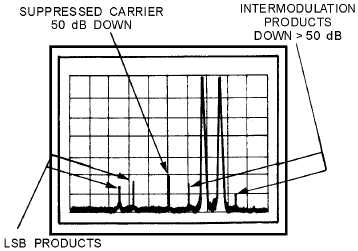5-19
Figure 5-18.—Two-tone test.
Q-5.
What is the advantage of single-sideband (ssb) transmission over AM transmission?
Frequency Modulation
In frequency modulation, the instantaneous frequency of the radio-frequency wave varies with the
modulation signal. As mentioned in NEETS, module 12, the amplitude is kept constant. The number of
times per second that the instantaneous frequency varies from the average (carrier frequency) is controlled
by the frequency of the modulating signal. The amount by which the frequency departs from the average
is controlled by the amplitude of the modulating signal. This variation is referred to as the FREQUENCY
DEVIATION of the frequency-modulated wave. We can now establish two clear-cut rules for frequency
deviation rate and amplitude in frequency modulation:
Amount of frequency shift is proportional to the amplitude of the modulating signal.
(This rule simply means that if a 10-volt signal causes a frequency shift of 20 kilohertz, then a 20-
volt signal will cause a frequency shift of 40 kilohertz.)
Rate of frequency shift is proportional to the frequency of the modulating signal.
(This second rule means that if the carrier is modulated with a 1-kilohertz tone, then the carrier is
changing frequency 1,000 times each second.)
The amplitude and frequency of the signal used to modulate the carrier will determine both the
number of significant sidebands (shown in fig. 5-19) and the amplitude of the sidebands (shown in fig. 5-
20). Both the number of significant sidebands and the bandwidth increase as the frequency of the
modulating signal increases.

